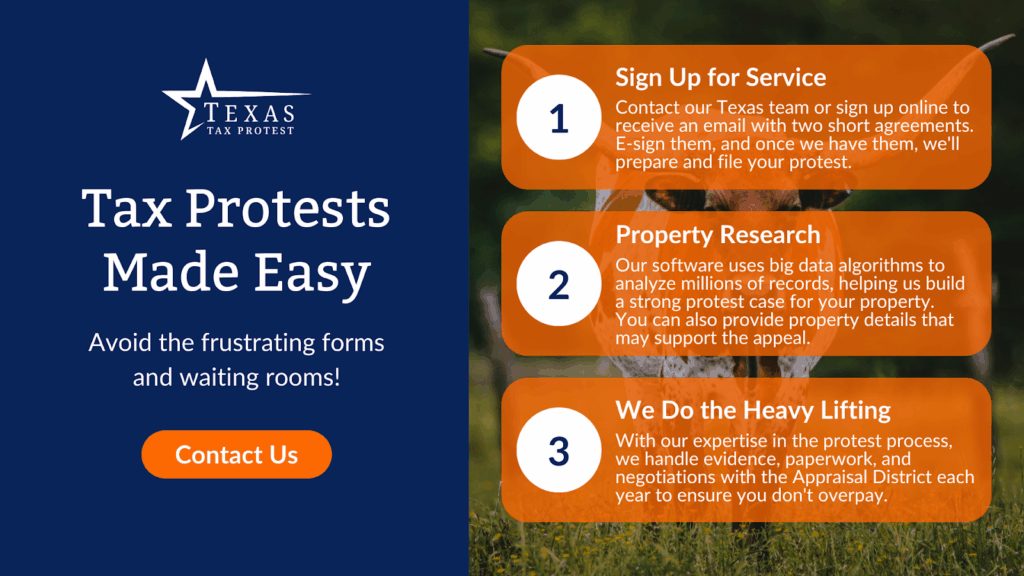
What Really Happens During a Property Tax Protest Hearing?
September 12, 2025
If you’ve filed a protest against your property tax appraisal in Texas, congratulations, you’ve already taken the most important step toward potentially lowering your tax bill. But what happens next? For many homeowners, the idea of a formal protest hearing sounds intimidating. The good news: it’s far less daunting than you might think. In fact, understanding what to expect during a property tax protest hearing can give you confidence and increase your chances of success.
Here’s a straightforward walkthrough of what really happens during a property tax protest hearing, from the notice you receive to the final decision.

Step 1: Receiving Your Hearing Notice
Once your protest is filed with your county’s Appraisal District, you’ll receive a notice by mail with the date, time, and location (or online login details) for your hearing. In many Texas counties, homeowners will first be offered an informal hearing with an appraiser before moving on to the formal hearing with the Appraisal Review Board (ARB).
Step 2: The Informal Hearing (If Available)
The informal hearing is a one-on-one meeting with a staff appraiser. This is often the best opportunity to present your evidence and potentially reach a resolution without needing to appear before the full board.
At this stage, you’ll share information like:
- Photos of property damage or needed repairs
- Comparable sales data for similar homes in your neighborhood
- Independent appraisals or contractor estimates
The appraiser will review your evidence and may offer to reduce your assessed value. If you accept the offer, the protest is resolved then and there. If not, you move on to the formal hearing.

Step 3: Preparing for the Formal Hearing
If you don’t reach an agreement during the informal hearing (or if your county doesn’t offer one), your case will be heard by the Appraisal Review Board, a panel of three citizens appointed to review protests.
Before the hearing, make sure to organize your evidence clearly. You don’t need to be a real estate expert to make your case, but strong documentation helps. Many homeowners choose to work with professionals like Texas Tax Protest at this point to make certain their evidence is presented strategically.
Step 4: The Formal Hearing
When it’s your turn, you’ll enter a small hearing room or join via a video conference. The ARB panel will be seated at a table or on a screen, and a clerk may be present to manage paperwork. A representative from the Appraisal District will also attend to explain how your value was calculated.
Here’s how the hearing typically unfolds:
- Introductions and Oaths: Everyone is sworn in. The chairperson briefly explains the rules and process.
- Appraisal District’s Presentation: The district presents its evidence and justification for the appraised value.
- Your Turn: You present your case, including documents, photos, and explanations.
- Questions: Board members may ask questions to clarify information from either side.
- Rebuttals: Each side has a chance to respond briefly to the other.
- Decision: After both sides finish, the board deliberates in private and usually announces its decision shortly after.
Step 5: After the Hearing
You’ll receive the ARB’s written decision by mail. If they agree with your evidence, your property’s assessed value will be reduced, and your tax bill will be adjusted correctly. If the board denies your request or you believe the outcome was unfair, you may have the option to appeal the decision to state court or through binding arbitration.
It’s Less Intimidating With Help
The formal hearing process is designed to be accessible for homeowners, but that doesn’t mean it’s simple. The Appraisal District comes prepared with data and experience, and many homeowners find it helpful to work with experts who know how to counter that information effectively.
Texas Tax Protest has saved homeowners over $85 million, with more than 10 years of experience navigating Texas protest hearings. Our real, Texas-based support team and proprietary software give each case a data-backed edge, helping you feel more confident and prepared.

Ready to Take the Next Step?
If you’re preparing for a property tax protest hearing or wondering whether you qualify, Texas Tax Protest is here to help. Contact us to get started.





